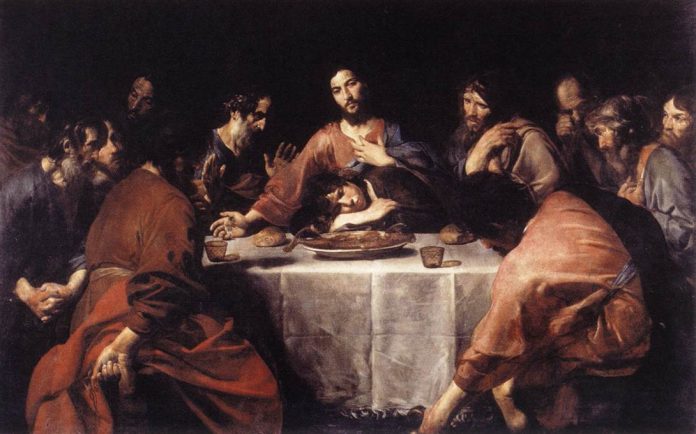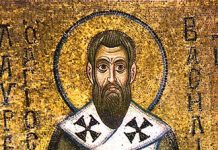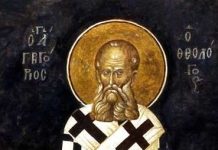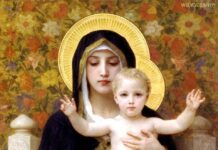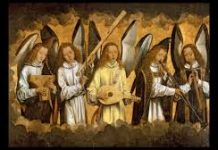Nineteenth Sunday Per Annum (C) August 11, 2019.
‘Do not be afraid, little flock, for it is your Father’s good pleasure to give you the kingdom’ (Lk.12:32). ⧾
These are perhaps among the most tender words addressed to us by Our Lord. He speaks to us with kindness and by means of the parables that we have just heard Our Lord teaches us that faith and vigilance are needed as we await His glorious return. Faith and vigilance are the enemy of spiritual sloth which has the power to extinguish the light of faith, the strength of hope and the ardour of charity. What is the kingdom? It is Jesus Christ Himself; and in Him we live and move and have our being (Acts 17:28). We possess the kingdom for Jesus is here; in His living Word, and He is substantially here in the Blessed Sacrament of the Eucharist. Do you really believe this?
Some of you may have heard of the results of a survey released this week in the US which shockingly states that only one third of Catholics in the United States agree with the Church’s teaching that the Eucharist is truly the Body and Blood of Our Saviour Jesus Christ. We are familiar with the word transubstantiation. It defines the miracle of the Eucharist: the change in substance or essence by which the bread and wine offered in Sacrifice of the Mass, become, in reality, the Body and Blood of Jesus Christ. The survey finds that most self-described Catholics do not believe this fundamental teaching of the Church. In fact, nearly seven-in-ten Catholics (69%) say they personally believe that during Mass, the bread and wine we offer at Holy Mass are symbols of the Body and Blood of Jesus Christ. Just one-third of U.S. Catholics (31%) say they believe that during Mass, the bread and wine actually become the body and blood of Jesus. Do these numbers shock you? What do you believe?
I will admit that I am not surprised by these numbers, which I doubt, are little different in our country. It is my hope however, that these statistics have no relevance to us here. I have laboured among you to bring you to the Tabernacle. Last Sunday, in our meditation on the sacred texts we once again made note of the fact that the affirmation of the truth our Catholic Faith and its celebration in the sacred rites left to us by Our Saviour is the source and summit of our lives. For a Catholic, the worthy reception of Holy Communion on Sunday is the single most important thing we do each week. We live for Sunday and we make our own the words of the North African Martyrs of Abitina: Sine dominico non possumus. We cannot live without the Sunday Eucharist. They were martyred in the year 304, for having worshipped on Sunday. This had been outlawed by decree of the Emperor. By God’s mercy, these are our sentiments, but many have forgotten this and many have never been taught it or if they were, they were taught poorly.
A new form of the Mass was imposed on the Church fifty years ago; and truth be told, the manner in which the Mass is celebrated in many places has in no small part contributed to this terrible Eucharistic crisis. In 1980, not long after the introduction of the new form of the Mass, Pope St. John Paul expressed grave concern over unfortunate developments and abuses of the liturgical reforms. As a corrective, he issued an Instruction, an official document called Inaestimabile Donum, Instruction Concerning Worship of the Eucharistic Mystery (Sacred Congregation for the Sacraments and Divine Worship, Approved and Confirmed by pope John Paul I, April 17, 1980). It is worth making note of some these abuses because they will help us to understand why things are as they are. The confusion of roles, especially regarding the priestly ministry and the role of the laity (indiscriminate shared recitation of the Eucharistic Prayer, homilies given by lay people, lay people distributing Communion while the priests refrain from doing so); an increasing loss of the sense of the sacred (abandonment of liturgical vestments, the Eucharist celebrated outside church without real need, lack of reverence and respect for the Blessed Sacrament, etc.). Then Instruction quotes St. Thomas Aquinas, the great Doctor and author of some of our most beautiful Eucharistic hymns and prayers; noting that in these cases, that is, these liturgical abuses, we are face to face with a real falsification of the Catholic Liturgy: ‘One who offers worship to God on the Church’s behalf in a way contrary to that which is laid down by the Church with God-given authority and which is customary in the Church is guilty of falsification’ (St. Thomas, ST., 2-2, Q. 93, A. 1.)
Nearly forty years have passed since this Instruction was addressed to Roman Catholics throughout the world and sadly, the state of things has not on the whole improved. We must be honest about this. Many have fallen away; Mass attendance has plummeted everywhere without exception, except among Catholics who attend the Traditional Latin Mass: 99% of Catholics who attend the Traditional Latin Mass attend Mass weekly versus 22% of those who attend what is known as the Novus Ordo Mass, or the Mass of Paul VI – what we are now celebrating. (https://onepeterfive.com/new-survey-shows-disparity-of-beliefs-between-latin-mass-novus-ordo-catholics/) What happened? To pose this question is not an act of defiance nor is it reactionary.
The decline of the Church, and I am not speaking here of her influence in the secular realm; no, the decline in what matters most, our work of giving glory to God and leading souls along the path of devout humility and to holiness, this decline began when the form of the Mass was altered. As we noted last Sunday, since God cannot be seen or heard directly, He conveys His summoning Word and inviting sign in a form that is audible, concrete and visible. This is what the Church is; and specifically, this is what the Mass is: an ancient form that is audible, concrete and visible. The form of the Mass is not arbitrary or inconsequential and as Catholics we must jealously guard the treasure of Sacred Tradition and appreciate that the Mass invites us to a lifetime of education. In the presence of this Mystery, one has never learned everything there is to learn. To have altered and changed what for centuries had sustained the faith and charity of millions has led to an attitude towards the sacred rites which in extreme cases makes a mockery of our faith.
‘Do not be afraid, little flock, for it is your Father’s good pleasure to give you the kingdom’ (Lk.12:32). The kingdom is Our Lord Himself. When we are convinced of this, no power on earth or under the earth can shake us. And where do we receive Him? Obviously, here; because here He is substantially present Body, Blood, Soul and Divinity. This is why in all truth we can say that the Mass is everything! The spiritual and yes, even the cultural richness of the Traditional Mass is arguably incalculable, inestimable. The Anglican theologian Catherine Pickstock of Cambridge University has said that the Traditional Rite of the Mass has been the driving force behind Western art – including music, painting and architecture. The appeal of the Traditional Mass however, does not lie in superficial reasons, but in its spiritual depth. This is why it is attracting young people and young families; and for this reason, it belongs to the future. Our future is indeed in Tradition. In all humility, we who are older must examine our conscience and see whether we now harbour a prejudice against Sacred Tradition because we have been adversely affected by the liturgical revolution and its ensuing chaos.
Some fifty years ago, when most of us here were much younger, there emerged what may be aptly defined as an attitude of arrogance towards the sacred and towards Catholic tradition (Cf. H. J. A. Sire, Phoenix from the Ashes: The Making, Unmaking, and Restoration of Catholic Tradition). The time has come for us individually and as a Catholic community to examine our attitude towards Sacred Tradition and to restore the sacred. The Traditional Mass unequivocally increases the light of faith, the strength of hope and the ardour of charity; and those who are immovable in their faith have a power beyond any statistical analysis. I invite all of you to experience the spiritual depth and beauty of the Traditional Mass this coming Thursday, the Feast of Our Lady’s glorious Assumption at 7:00 p.m. Our monthly Marian Procession will follow the Mass. May Our Lady obtain for each of us here the grace of a humble and docile heart. ⧾

